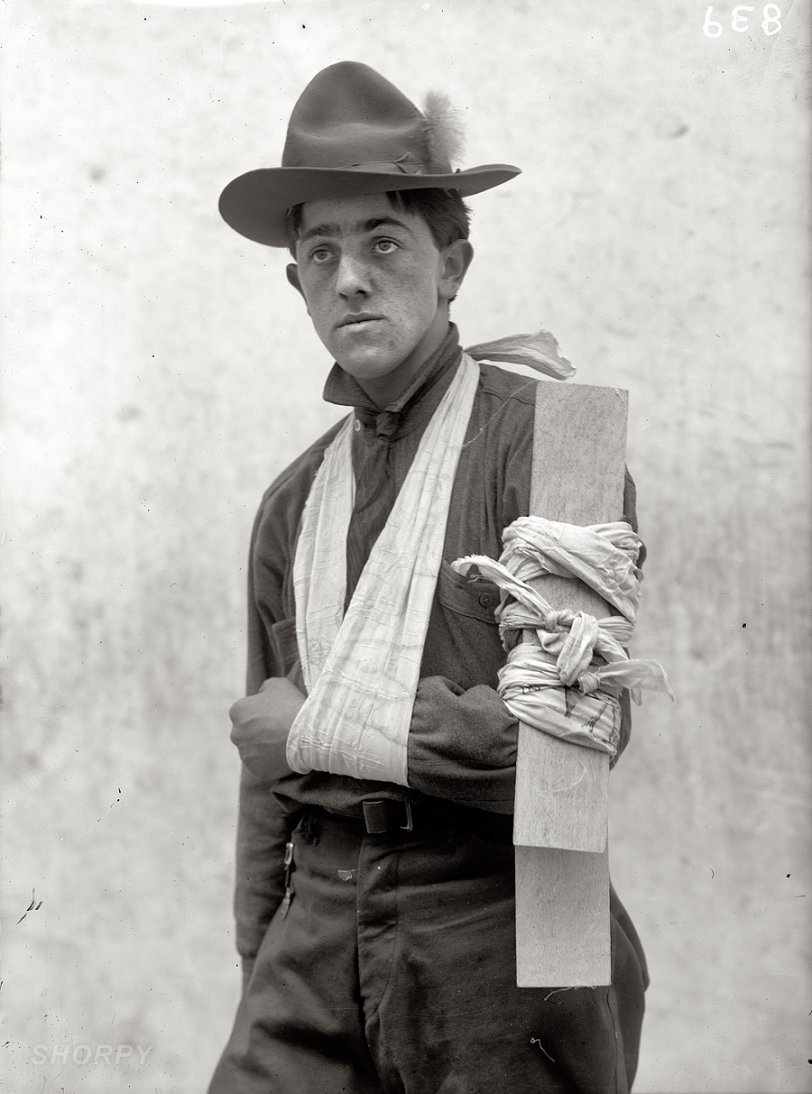


Framed or unframed, desk size to sofa size, printed by us in Arizona and Alabama since 2007. Explore now.
Shorpy is funded by you. Patreon contributors get an ad-free experience.
Learn more.

- Baldwin 62303
- Baldwin VO-1000
- Cold
- No expense spared
- Tough Guys
- Lost in Toyland
- And without gloves
- If I were a blindfolded time traveler
- Smoke Consumer Also Cooks
- Oh that stove!
- Possibly still there?
- What?!?
- $100 Reward
- Freeze Frame
- Texas Flyer wanted
- Just a Year Too Soon
- WWII -- Replacing men with women at the railroad crossing.
- Yes, Icing
- You kids drive me nuts!
- NOT An Easy Job
- I wonder
- Just add window boxes
- Icing Platform?
- Indiana Harbor Belt abides
- Freezing haze
- Corrections (for those who care)
- C&NW at Nelson
- Fallen Flags
- A dangerous job made worse
- Water Stop
Print Emporium
Still Standing: 1912

"Boy Scout training demonstration, 1912." Fifth in our series of bandaged, splinted and faux-injured Scouts. Harris & Ewing glass negative. View full size.
Love Your Artwork
Love the artwork. I wish I had the talent to reproduce an image from a monochrome photo and add the colors that you've done here. Kinda replication - Kinda caricature - Kinda cartoon - Great originality!
I wish I had the talent to reproduce a color photo into a color painting, for that matter.
Neckerchiefs
The old full-square 30x30 neckerchiefs were handsome and useful. Those made prior to 1930 were a lightweight silky cotton pongee that could sustain a strain of many pounds on the warp and woof of the fabric. They looked great and felt great around the neck - and they were vital in performing many a good deed.
Inspiring
This is the first comment I've left here on Shorpy, although I come here every day for a dose of inspiration.
I found this series of Boy Scout photos particularly wonderful, so decided to illustrate my take on this photo. There might be more of the six in the works as well.
[That's really wonderful. Please keep us posted. I found a few more of these btw. - Dave]

Be Prepared
Another thing which had changed about Scouting between 1912 and the 70's (which was when I became a Scoutmaster) is the size and nature of the neckerchief worn by Scouts.
From sometime in the late 60's, the neckerchief was a relatively small triangular piece of cloth. In 1912 it was a very large piece of cloth, folded into the triangular shape we knew in the 1970's. It was more than large enough when unfolded to use as a sling or (as shown in the pictures) to tie up a splint.
The BSA first aid material into the 80's still recommended using the neckerchief as a sling, much to the confusion of my Scouts, only the smallest of whom could fit their arms into a sling made from the new style neckerchief.
When I was a scout
When I was a scout (An Eagle over 20 years ago) we made splints similar to this. As I recall from the BSA manual we were supposed to use something straight, if you could get flat that would be preferable. We used our neckerchiefs for the bindings, although this young man appears to have used something that looks like it has a printed tee-pee on it. (Any chance we can get a closeup of that arm splint?) We used two scout shirts and two shovels to make a stretcher. Scout training is to be prepared for ANYTHING. Accidents and disasters don't just happen in the woods.
I'd be willing to bet that there were more than a few people in New Orleans after Katrina who would have been happy to have availed themselves of this young man's training. Plenty of flat wood for splinting to go around there too.
Be Prepared
Of course. I was merely being facetious. Having been in the Boy Scouts at a much later date than this young man (in the 1970s), I will say that the idea behind scouting had shifted considerably by the time I earned Tenderfoot rank. And our troop was taught some of the basics of camping outdoors, which probably was not necessary in this young man's day.
I do recall, hazily, the idea that one should pack efficiently when camping, but not to forget things that might not spring immediately to mind, such as clean towels and washcloths. Not only or primarily for washing with, but for on-the-spot First Aid use as bandages, splint ties, or tourniquets. In the wild, you would probably not find a clean piece of lumber such as that pictured. You would more likely look for a small, sturdy, reasonably straight limb. And you would most certainly use your hatchet to separate it from the tree, if you had your Totin' Chip.
Thanks for posting this picture, as the discussion has brought back some interesting memories.
Re: Splinters
I suppose the sheets would be found in one's backpack when out in the wilderness — in the spirit of being prepared, one never knows when a formal dinner may spring up whilst hiking in the woods. And the lumber probably comes from something you can whittle from a nearby pine tree with your hatchet, assuming you have your Totin' Chip.
[Back in the day, Boy Scouts were viewed as something like a youthful adjunct to the National Guard, and not necessarily just happy campers out in the woods. The idea was preparedness in the event of an emergency, whether it was in the city or the countryside. - Dave]
Lovely expression
It seems to say, "Well, my arm may be horribly broken, but at least I have a jaunty hat!"
Oops Troop
This whole troop certainly seems to be accident-prone.
























On Shorpy:
Today’s Top 5